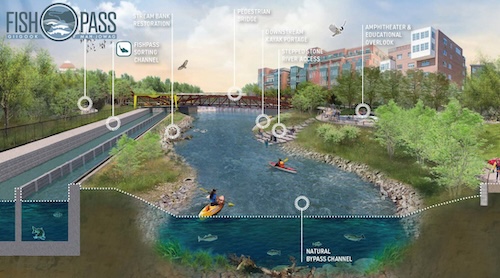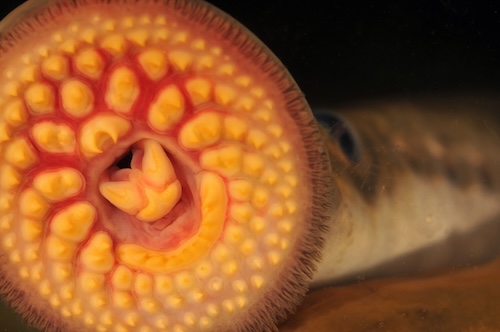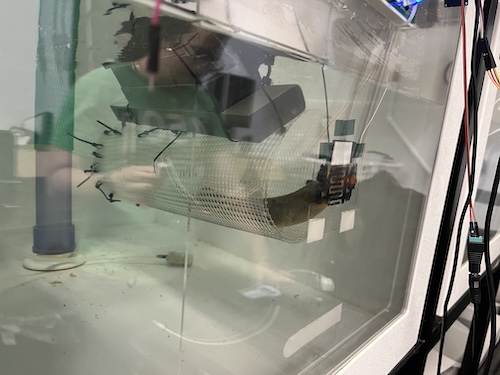Michigan State University researchers are tackling a problem no one has ever solved: How do you stop an invasive fish from entering a river without entirely blocking all fish?
A behavioral ecologist and two engineers are on a team commissioned by the Great Lakes Fishery Commission, or GLFC. Their objective? Over the next decade, they’re charged with creating a groundbreaking selective fish barrier in Traverse City that’s hailed as the “Holy Grail” of invasive species control. If successful, the barrier, called FishPass, will be the first ever barrier to sort and selectively pass desirable fish, such as lake sturgeon and walleye, into the river, while blocking the invasive and parasitic sea lamprey.

FishPass is the culmination of an effort to reconnect the Boardman/Ottaway River in Traverse City with Lake Michigan. Construction workers broke ground on the project in May, and the state of Michigan recently earmarked $1 million in its budget to support the GLFC efforts. Once FishPass is complete, the goal is to create replicable technology that can be used around the world as a model for invasive species control.
Michael Wagner, an associate professor in the Department of Fisheries and Wildlife’s Applied Behavioral Ecology Lab, is helping the team as an expert on sea lampreys. In a concurrent project, MSU engineers Xiaobo Tan, MSU Research Foundation Professor and Richard M. Hong Endowed Chair in electrical engineering, and Nelson Sepulveda professor of electrical engineering and interim chairperson of Electrical and Computer Engineering, are developing smart panels that could potentially be used as a tool in FishPass.
They’re joining researchers from other universities as well as a core team from state and federal organizations, including the U.S. Geological Survey, the Michigan Department of Natural Resources and the Grand Traverse Band of Ottawa and Chippewa Indians.
Researchers are using what they know about sea lamprey behavior to stop them from reaching the Boardman/Ottaway River before they get a chance to spawn, while letting native fish pass through. How will it work? The team will spend the next 10 years figuring that out, experimenting and testing different techniques to determine how they’ll accomplish selective passage.
A project of this magnitude could only be accomplished through collaboration, said Tan, who is also director of the Smart Microsystems Lab in the College of Engineering’s Department of Electrical and Computer Engineering. Tan is known worldwide for developing a robotic fish, and while he’s an expert in his field, he couldn’t have approached this project without collaborating with researchers in other disciplines, he said.
“When we talk about aquatic ecosystems or animals in water, there’s naturally a need for collaboration,” Tan said. “You have water experts, you have fish ecology experts, and you have engineers like me. Solving these real-world problems requires partnerships across different disciplines and even different institutions.”
A 20-year project
FishPass is the capstone of a massive river recovery project that’s being called the largest comprehensive dam removal effort in Michigan’s history. Since the 1800s, the Boardman/Ottaway River was segmented with dams built for flour mills and supplying electricity with hydropower. An unintended consequence was the dams also disrupted the natural flow of rivers and blocked native fish and wildlife from their habitats.
Today, there’s an increasing effort to restore natural river flow. Over the past two decades, three upstream dams were torn down one by one to reconnect 160 miles of the Boardman/Ottaway River. The Union Street dam in Traverse City is now all that stands between the river and Lake Michigan.
The current dam was aging and needed to be replaced. Simply removing it was not an option — Lake Michigan is now home to fish that weren’t there when the original dam was built, including sea lampreys.
Vampire fish
Sea lampreys are eel-like, parasitic fish with an open sucking disk for a mouth. They’re sometimes called “vampire fish” because they attach themselves to other fish with their sucking disk that’s filled with teeth surrounding a tongue that acts like a drill. They don’t detach until they’ve fed on the fish’s body fluids, often killing the fish in the process. A single lamprey typically destroys up to 40 pounds of host fish by the time it reaches spawning age, Wagner said.

Sea lampreys found their way into the Great Lakes in the 1800s through manmade locks, including the Welland Canal in Ontario, Canada. While the Great Lakes are home to a variety of other native lampreys, sea lampreys are much larger — as big as 20 inches long — and more destructive. The GLFC blames sea lampreys for decimating the Great Lakes once-robust population of lake trout, whitefish and chub. Lake Michigan’s catch alone dropped from 5.5 million pounds in 1946 to just 402 pounds seven years later, according to the GLFC.
The U.S. Fish and Wildlife Service fought back. Scientists at the USGS Hammond Bay Biological Station developed and tested a chemical known as lampricide to kill sea lamprey larvae without contaminating the water or harming other plants and animals. They applied it to Michigan’s 400 rivers every few years, where sea lampreys are known to spawn. Thanks to the program, the Great Lakes sea lamprey population is down 90% from its peak, Wagner said.
Connectivity conundrum
The GLFC also relies on barriers such as dams to keep sea lampreys out of rivers, reducing the amount of chemicals they’ll need to treat tributaries where the fish spawns. Unfortunately, those barriers also block native, desirable fish species from entering those waters, GLFC Principal Engineer and Scientist Dan Zielinski said.
“That’s where this connectivity conundrum comes into play,” Zielinski said. “You have to make the management decision of either barrier removal for improved connectivity, versus barrier retention for invasive species control. FishPass came about as a solution to that problem.”
A new barrier would have to be built in order to keep sea lampreys out. But what if there was a way to sort out fish native to the Great Lakes and let them into the river? Such a barrier didn’t exist, but the GLFC team decided to pursue creating its own.
Until now, the only selective barriers were designed for passing Pacific salmonids, such as coho, chinook and steelhead. These fish can jump over barriers and swim into high flows. FishPass is unique because it will allow a wide variety of native fish to swim through while specifically blocking sea lampreys. Zielinski calls it the “Holy Grail” of invasive species control — many have searched for it, but no one has succeeded.
The idea for FishPass was inspired by single-stream recycling. Instead of sorting recyclables by hand, a mixture of materials is sent to a central facility that sorts the materials by performing a variety of tasks, such as picking up metal with magnets and blowing paper with air. In theory, by studying the attributes of different fish, FishPass can use obstacles and traps that separate fish by their size, shape and known behaviors. The problem is, fish are living things and might not respond the same way to stimuli every time.
“These aren’t inanimate objects,” Wagner said. “Nonferrous metal can’t choose to not be attracted to a magnet. But when you’re trying to get an animal to do something in the environment, it may not do it.”
Using sea lamprey traits against them
The FishPass infrastructure includes an adaptable 400-foot-long, 30-foot-wide channel in the Boardman/Ottaway River. Fish will follow the natural flow of the river, and Zielinski said researchers are working through their shortlist of possible technologies to develop and test for the best way to block sea lampreys.
The first mechanisms may sort fish based on size. For example, lake sturgeon are easily identifiable because they’re so large. From there, Zielinski said, they’re working on tools based on their research on alarm cues and pheromones, among others.
Sea lampreys are solitary, nocturnal animals that rely on their sense of smell when they migrate, Wagner said. Unlike salmon, they don’t return to the river where they were born to spawn. Instead, it chooses a river based on the odor of sea lamprey larvae already in the water.
Injured lampreys also release an odor from their skin called an alarm cue, alerting other sea lampreys to avoid the area because an attack has occurred. Conversely, the scent of a male sex pheromone can attract a female that is tens of kilometers away. Wagner is working on how scientists can use scent cues to manipulate sea lampreys into swimming into a trap where they can be caught. They’re also looking at using sound, bubbles or lights to convince fish to swim one way or the other.
“The solutions that we work on are largely rooted in how we can change the information landscape from an animal’s perspective, so that it either goes where we want it to go, or where it doesn’t want to go,” Wagner said.
One unique characteristic of sea lampreys is their propensity to attach to rocks or logs. When they need to rest, they’ll use their wide sucking disc to latch onto the object, allowing it to stay in place even in a river’s current. That gave Tan, who was already familiar with underwater robotics, the idea for a smart panel, a concurrent project also funded by the GLFC. While not part of FishPass, the smart panels could be used as a tool within the project to stop sea lampreys.
Using what Wagner knows about how sea lampreys move in a river, they’ll guide the lampreys into a tunnel that has smart panels mounted on the walls. Once the lampreys attach themselves to the panel, the suction will trigger sensors that alert FishPass monitors to their presence or activate automated control responses to block passage. For example, the panel could apply an electric shock to paralyze the sea lamprey.

Tan and Sepulveda are developing two different technologies for realizing the smart panel. One directly measures the pressure profile created by the lamprey suction. The other measures contact on the panel through interdigitated electrodes.
Other than the FishPass application, they’re also exploring other uses of the smart panels. One application might be detection of sea lampreys in tributaries during spawning season, so that sea lamprey control agents know when to put traps or barriers in place.
Sepulveda said they’re also working on machine learning algorithms that would allow the collection of sea lamprey demographics. USGS researchers could then use that data to better understand sea lamprey behavior and see patterns in their movement.
A backstop to the system could be based on image recognition technology, Zielinski said. This only works if the flume isn’t seeing a large number of fish pass through, but he’s working with researchers at Central Michigan University on an algorithm that looks promising.
Measuring success
FishPass will have two measures of success. First, GLFC will check for whether desirable fish are passing through and reproducing. Fish that are allowed through FishPass will be tagged and tracked as they swim upstream, Zielinski said. The GLFC will also conduct other projects to look at how those fish contribute genetically to future generations of fish in the river.
Second, scientists will continue to look for sea lamprey larvae in riverbanks to determine if any of the invasive fish slipped through. The GLFC, Grand Traverse Band of Ottawa and Chippewa Indians and the Department of Natural Resources will also conduct annual surveys to measure the fish community above and below FishPass.
Eventually, the goal is fully automated selective passage. In the immediate 10-year period, however, the GLFC says any fish passed through the system will be coordinated with fishery management agencies. They’ll pass only species native to the upper Great Lakes and only in limited numbers.
Wagner said the results may not be perfect. They might not initially be able to pass every desirable fish they’d like to see in the river. But he’s confident they’ll be able to stop sea lampreys, and with trial and error, they’ll keep refining and improving FishPass.
“It’s a concept,” he said. “It’s not like we’re taking something that succeeded elsewhere and tweaking it. We’re trying to do something nobody’s ever done before.
